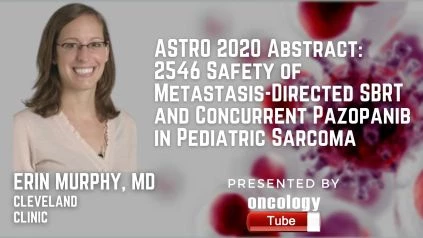Erin Murphy, MD of the Cleveland Clinic discusses the ASTRO 2020 Abstract 2546 Safety of Metastasis-Directed SBRT and Concurrent Pazopanib in Pediatric Sarcoma.
BodyÂ
Purpose / Goal(s):
In the definitive treatment or palliation of metastases in pediatric sarcoma, stereotactic body radiation therapy (SBRT) is increasingly being used. In addition, multi-site tyrosine kinase inhibitors (TKIs) such as pazopanib are gradually suggested following the progression of metastatic disease to systemic therapy. Although the safety profiles of TKIs are well studied and it is possible to deliver high doses of radiation safely using SBRT, the safety of their simultaneous administration remains unknown. We hypothesized that with concurrent pazopanib, metastasis-directed SBRT would be well-tolerated with reduced toxicity.
Methods/Materials:
An IRB-approved list of patients treated with SBRT for pediatric sarcoma metastases was queried between 2015-2019. Toxicity was measured for patients < 50 years of age who received concurrent pazopanib (within 7 days prior to RT onset). Toxicities were listed in compliance with CTCAE v4.0.0.
Outcomes:
Ten patients with 13 lesions in total meet the requirements for inclusion. The patient was diagnosed with osteosarcoma (50%; 5 out of 10 pts), Ewing sarcoma (40%; 4 out of 10 pts), and synovial sarcoma (10%; 1 out of 10 pts). The mean age of the patient at the completion of treatment was 16.3 years ( range 9.6-36.1). The median KPS for therapy was 80. There were five (38%) osseous lesions, 4 (31%) parenchymal (lung) lesions, and 4 (31%) soft tissue lesions. In 5 fractions (range 1-5), the median radiation dose was 3500 cGy (range 1600-5000). With systemic treatment, patients were heavily pre-treated. The median time for follow-up was 10.3 months. Acute grade 1 toxicity consisting of fatigue and esophagitis was encountered by three patients (30 percent). Acute grade 2 exposure consisting of cough, nausea, and radiation dermatitis was encountered by three patients. Late Grade 1 myositis was experienced by one patient. No grade 3 toxicities were present.
The Conclusion:
This is the largest retrospective sequence to examine the protection of SBRT with pazopanib concurrent. With low acute or late toxicity, the procedure was well-tolerated.

